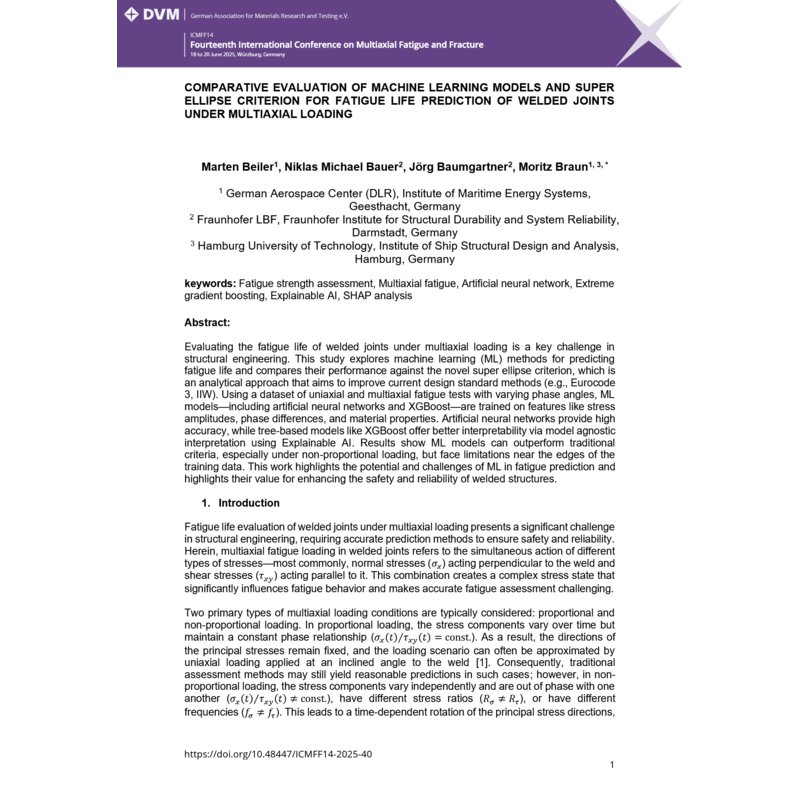- Nur online erhältlich



Fatigue life evaluation of welded joints under multiaxial loading presents a significant challenge in structural engineering, requiring accurate prediction methods to ensure safety and reliability. This study compares various machine learning (ML) approaches to state-of-the-art design criteria and the extended Gough-Pollard criterion for assessing the fatigue life of welded joints. A comprehensive dataset comprising uniaxial fatigue test results under nominal and shear loading, as well as multiaxial fatigue test data with varying phase angles, forms the basis of the analysis. The ML models are trained to predict fatigue life using a diverse set of features derived from stress amplitudes, phase differences, and material properties. State-of-the-art design criteria from standards such as…

Datenschutzbedingungen (bearbeiten im Modul "Kundenvorteile")

Lieferbedingungen (bearbeiten im Modul "Kundenvorteile")

Rücksendebedingungen (bearbeiten im Modul "Kundenvorteile")
Fatigue life evaluation of welded joints under multiaxial loading presents a significant challenge in structural engineering, requiring accurate prediction methods to ensure safety and reliability. This study compares various machine learning (ML) approaches to state-of-the-art design criteria and the extended Gough-Pollard criterion for assessing the fatigue life of welded joints. A comprehensive dataset comprising uniaxial fatigue test results under nominal and shear loading, as well as multiaxial fatigue test data with varying phase angles, forms the basis of the analysis. The ML models are trained to predict fatigue life using a diverse set of features derived from stress amplitudes, phase differences, and material properties. State-of-the-art design criteria from standards such as Eurocode 3 and the International Institute of Welding and the extended Gough-Pollard criterion, a novel analytical method, serves as a benchmark for evaluating ML performance.
ML methods offer a promising alternative to computational science-based methods, as ML methods are particularly adept at capturing and modeling complex data interactions. The potential of ML has been demonstrated in numerous studies; nevertheless, significant differences exist between ML models. Traditional ML models are statistical in nature, focusing on the identification of patterns within the data, whereas neural networks learn to approximate complex relationships in data by adjusting weights in a layered structure, using nonlinear activation functions to capture both simple and intricate patterns. Both approaches offer distinct advantages. Neural networks, as purely black-box models, often achieve higher accuracy compared to traditional ML methods; however, models that leverage data patterns directly tend to be more interpretable, enabling reliable interpretation of results and uncovering hidden correlations within the data.
This study, thus, aims to investigate the potential of different ML methods for modeling the multiaxial fatigue behavior of welded joints. The research specifically seeks to analyze data interactions leading to the fatigue life predictions, compare the results with assessments from guidelines, and assess the interpretability and effectiveness of these methods in providing insights into complex fatigue phenomena. Beyond neural networks, the study also employs the ensemble tree-based algorithm, Extreme Gradient Boosting (XGBoost), to predict fatigue life based on multiaxial fatigue test data from welded joints, with the resulting predictions being compared. To facilitate model-agnostic interpretation of the XGBoost predictions, the Shapley Additive Explanations (SHAP) framework is utilized.
Results demonstrate the potential of data-driven approaches to outperform traditional criteria in capturing complex multiaxial loading effects, particularly under non-proportional loading conditions; however, ML models face prediction challenges at the borders of the training data space. This work highlights the advantages and limitations of ML models for fatigue life prediction and provides insights into their application to enhance the reliability of welded structures subjected to multiaxial stresses.